AMMAN — Too frequently, albeit in passing, you hear people complain about Jordan’s
perceived limited offering of local and regional art displays. DAR Art Fair has
come again to prove skeptics wrong.
اضافة اعلان
Named after co-founders Dina Dabbas Rifai and Rania
Omeish, DAR Art Fair is the founders’ brainchild in its second edition. The
fair creates a home for works of over 200 independent artists and 15 galleries
from 18 countries across the Middle East and Africa.
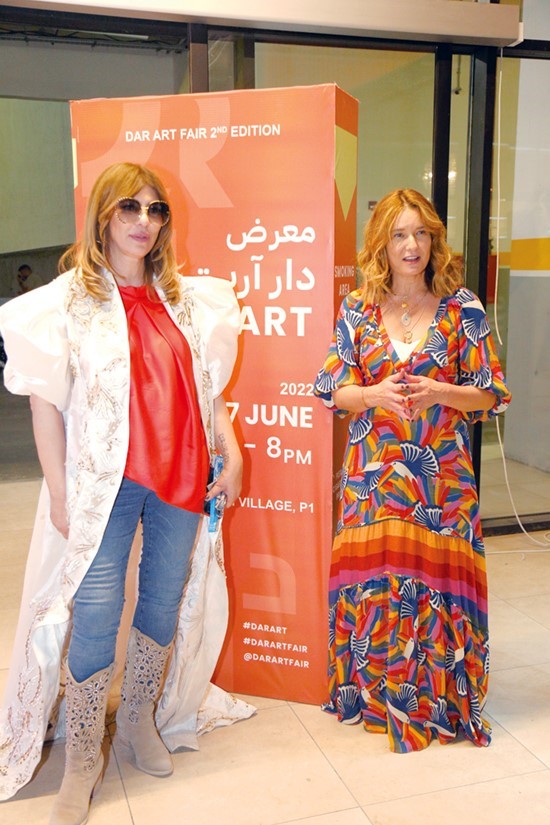 DAR Art Fair co-founders Rania Omeish (left) and Dina Dabbas Rifai. (Photo: Handout from DAR Art)
DAR Art Fair co-founders Rania Omeish (left) and Dina Dabbas Rifai. (Photo: Handout from DAR Art)
“Internationally, there are art fairs; why is Amman
the exception? This is a segment of forgotten people, and we have to motivate
them,” said Omeish highlighting the fair’s purpose.
Occupying a space of 1,400sq.m. in Swefieh Village
P1, the works are separated into two sections — independent artists and
galleries. But they are threaded by more than just common contemporary themes
with a few modern works.
Lebanese artist and curator Abed Al-Kadiri, who
resides in Paris, is the fair’s first curatorial consultant. His intricate
placement choices adorned the halls, never once leaving space for confusion but
leaving plenty for interpretation.
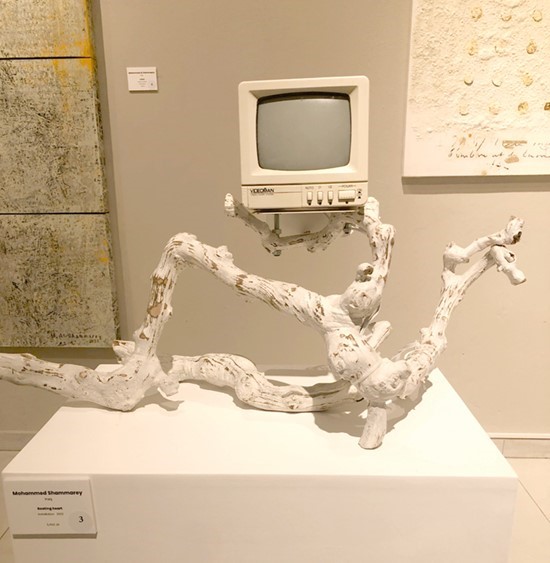 Mohammed Shammarey’s “Beating Heart”. (Photo: Jordan News)
Mohammed Shammarey’s “Beating Heart”. (Photo: Jordan News)
The fair welcomes you with muted whites splashed
with darker yellows and textured matter on canvas with Haasan Bourkia’s work,
evoking a familiarity with a building abandoned yet marked with traces of life
and love through consistent renovation. Softly, it serves as the backdrop to
Mohammed Shammarey’s “Beating Heart”, a skeletal yet branch-like figure
twisted in all ways but natural yet successfully carrying a dated mini-TV,
presenting an eye-grabbing commentary on the history of co-existence.
Despite the earthy entrance, you are quickly
contrasted with pieces that serve as a reflection of our current moment with
colorful works that accent the mundane, or lack thereof, of crowds and
escalators. Almost swiftly, the works continued from Sheikha Ibrahim Al
Nasser’s embroidered “Untitled”, which presents an integrated community on a
single fabric, to Sara Ramahi’s “The psycho-social support session”, bringing
us back to the dinner table with our father as children.
Nothing in the halls is taken for granted, and the Arab thread, which Omeish and Rifai emphasized, can be seen across the board and not in its usual polished manner.
The works speak, in a familiar hushed whisper, a
language predated by only a decade from the one we fluently babble. Yet,
although — sometimes — ambiguous, the language leaves us in awe. Meditations on
daily encounters become the norm (Hani Dallah Ali’s “Untitled” hammers home the
beauty of sitting and having mail).
Nothing in the halls is taken for granted, and the
Arab thread, which Omeish and Rifai emphasized, can be seen across the board
and not in its usual polished manner. The curtain is lifted: bodies (Mai
Qaddoura’s “Floating”), drugs (Paolo Farran’s “things we leave behind”),
politics and religion (Saleh Al Malhi’s 1943–2013 works from Hindiyeh museum’s
private collection), and gender and family dynamics (Nagham Khader’s “Out of
her father’s house”) are all on the table.
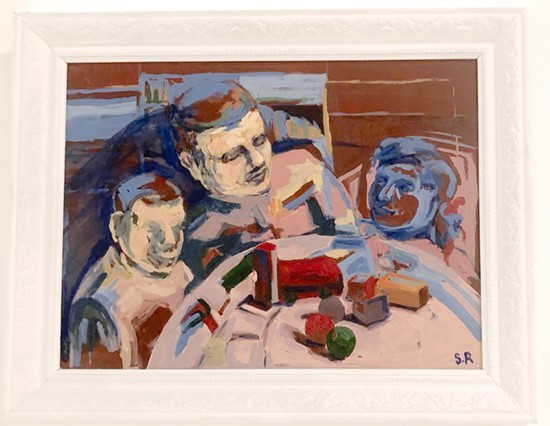 Sara Ramahi’s “The psycho-social support session”.
Sara Ramahi’s “The psycho-social support session”.
None of the works were chosen hastily, but all the
individual art section was chosen blindly. After the open call for submissions,
where 360 emerging artists sent in works, 26 percent were accepted, and the
rest of the displayed works were established and invited artists.
According to co-founder Rifai: “This year we had a
selection committee that picked the art after they were shown anonymously,” and
selections were not based on names “but based on the merit of the artwork”.
“Some of the works were submitted as sketches, and
these were the ones we started with. To give them enough time to complete their
works.”
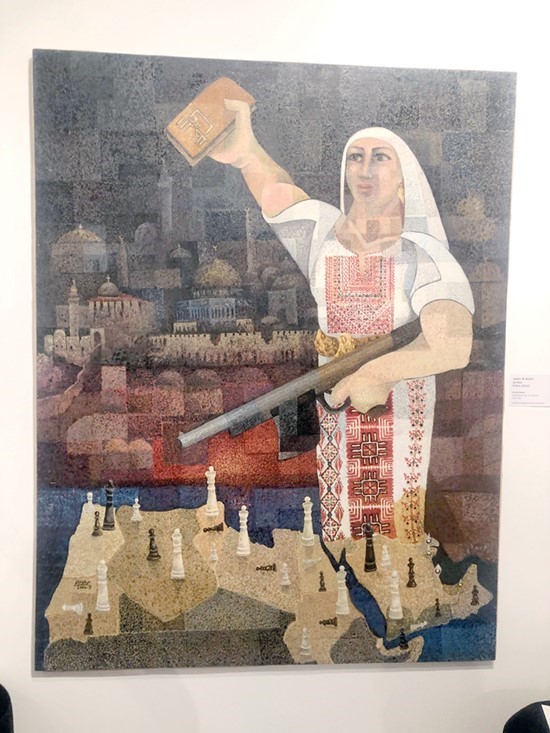 Works by Saleh Al Malhi (1943–2013) from Hindiyeh museum’s private collection.
Works by Saleh Al Malhi (1943–2013) from Hindiyeh museum’s private collection.
However, the fair’s treasure trove, a staple of
Rifai and Omeish’s commitment to presenting art as it grows internationally and
locally, is the digital room. It includes NFTs, video art, and augmented
reality (AR) properly presented in Jordan for the first time.
The digital art room is home to 11 of Emergeast’s
artists.
Emergeast was founded in 2014 by two women, Dima
Abdul Kader and Nikki Meftah, and is the MENA region’s first and leading online
gallery. It “represents emerging and mid-career MENA artists,” said Emergeast
Digital Content and NFT Manager Alia Kawar.
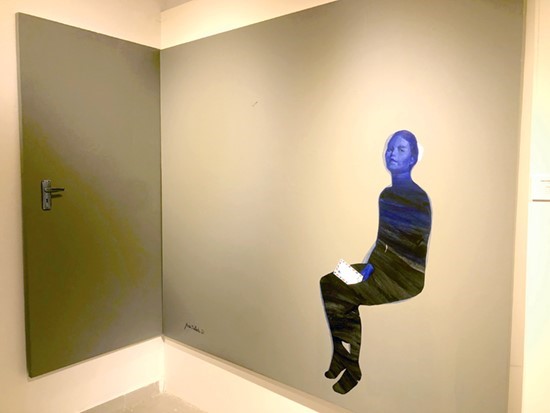 Hani Dallah Ali’s “Untitled”.
Hani Dallah Ali’s “Untitled”.
The works, from an infinity mirror and an AR man, to
more tangible snippets of daily life — cartoon-like faces opposite of each
other blinking and a naked woman presenting utmost comfort in her living room —
welcomed questions, and though they were continuously changing, they demanded
attention.
Much like Rifai and Omeish, who reiterated the
importance of presenting digital art properly in the Middle East, Kawar
highlighted that an NFT space was a “natural extension to Emergeast’s ethos,
which is to make art more accessible”.
Beyond digital art, galleries, and individual
artists, the fair holds a lively crowd and a cozy atmosphere; a nod to Omeish
and Rifai’s tireless efforts (the “buzz room” is decorated with Omeish’s home
furniture).
Show Album
(Photos: Ameer Khalifeh/Jordan News)
Walking through provides a fresh take on the dull
minute details of daily life through art. The area is crowded, yet the art
stands out, and there is room for everyone regardless of age, taste, or
expertise.
So, “come and come quickly. Look at the beautiful
art, and just enjoy the tremendous amount of talent we have in this part of the
world,” advised Rifai.
“Take your time, come with whoever you feel
comfortable with, and enjoy. Ask around and look at works once and twice. What
you see the first time might change the second time,” said Omeish.
The fair runs till June 7. And as you wander, keep in mind
Omeish’s advice to experience the art fully and “feel the space”.
Read more Culture and Arts
Jordan News





